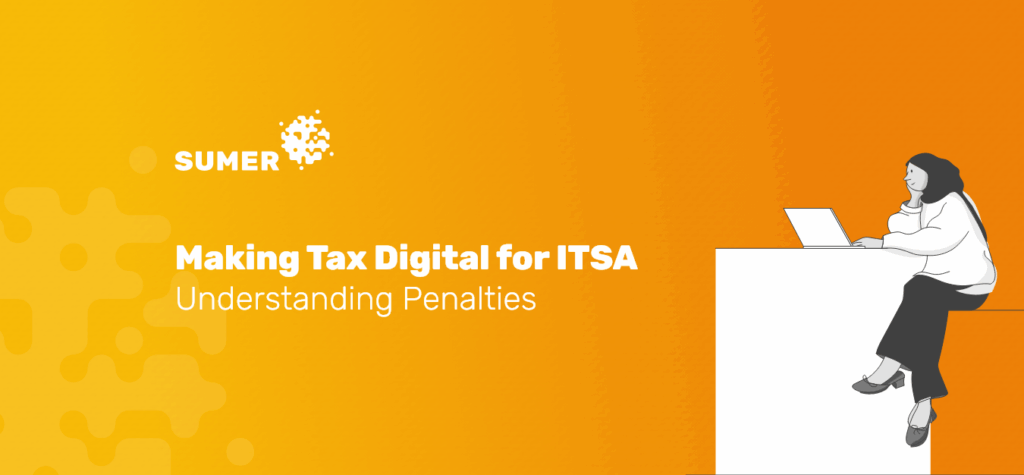Making Tax Digital for ITSA: Understanding Penalties
With the next phase of Making Tax Digital for ITSA fast approaching, many sole traders and landlords still have work to do to get ready. From 6 April 2026, MTD for Income Tax Self-Assessment (ITSA) will become mandatory for individuals with annual business or property income over £50,000.
However, despite this deadline, a recent survey by IRIS revealed that 45% of UK sole traders feel unprepared for the changes, meaning nearly half could face penalties once the new rules come into effect.
Who will be affected first?
If you currently file a Self-Assessment tax return and your turnover is £50,000 or more from self-employment and/or property income, you’ll need to follow the new MTD for Income Tax rules from April 2026.
| Tax Year assessed | Qualifying income threshold | MTD for ITSA begins | First tax year using MTD for ITSA |
|---|---|---|---|
| 2024/25 | £50,000 | By 6 April 2026 | 2026/27 |
| 2025/26 | £30,000 | By 6 April 2027 | 2027/28 |
| 2026/27 | £20,000 | By 6 April 2028 | 2028/29 |
What will change under Making Tax Digital?
It means you must:
- Keep digital business and property records
- Use HMRC-approved compatible software
- Submit updates every three months through that software
- Finalise your tax position at the end of the year through a digital declaration
This approach is designed to make tax reporting more accurate and timely, but it also means sole traders and landlords will need to be organised and digitally capable before April 2026.
You can find out more about the changes here.
Understanding the new penalty system
For late submissions, HMRC have introduced a new points-based penalty system, similar to the VAT system.
For every missed quarterly update, you’ll incur a penalty point. Once you reach the threshold (four points for quarterly filers, two for annual), a £200 fine applies.
Late payment penalties can apply to any Income Tax Self Assessment payments not paid in full, by the relevant due date. This could include balancing payments and amounts due following an amendment or assessment.
It’s important to note that, again similarly to VAT penalties, if there is a delay in making the payment then it will increase. Payments made between day 16 and day 30 attract a late payment penalty of 3% of the balance outstanding and if still not paid by day 30, the penalty increases to 6%.
After that, a daily charge will be imposed, based on a annual rate of 10% until the balance is cleared. For anyone struggling to pay, a Time to Pay arrangement can be set up with HMRC to stop penalties from building up further.
Making Tax Digital submission dates to remember
| Quarter | Period covered (Calendar Quarter) | Filing Deadline |
|---|---|---|
| 1 | 6 April to 5 July or (1 April to 30 June) | 7 August |
| 2 | 6 April to 5 October or (1 April to 30 September) | 7 November |
| 3 | 6 April to 5 January or (1 April to 31 December) | 7 February |
| 4 | 6 April to 5 April or (1 April to 31 March) | 7 May |
Do Making Tax Digital penalty points expire?
The short answer is yes, points will expire, but only after a sustained period of meeting all filing deadlines, so it’s important to stay on top of these after any penalties incurred.
Missed deadlines aren’t the only reason for penalties being issued
HMRC can also impose up to £3,000 in fines for failing to keep adequate digital records.
And they and can issue a £300 minimum fine for deliberately concealing information from HMRC that’s needed to assess your liability. So, making sure you have compatible software in place is essential.
Exemptions
Not everyone needs to follow the rules for Making Tax Digital (MTD) for Income Tax. If it’s not reasonable for you to use MTD-compatible software to keep digital records or send updates to HMRC, you may be digitally excluded. You may qualify for a digital exclusion exemption for example if: you cannot reasonably use technology due to age, disability, or location (for example, poor internet access)
If you think this applies to you, you can check whether you’re eligible for an MTD exemption from HMRC.
Other Exemptions
Some individuals and entities are automatically exempt from Making Tax Digital and do not need to apply for an exemption. You are automatically exempt if you are:
- completing a tax return as a trustee, including charitable trustees and trustees of non-registered pension schemes
- a person without a National Insurance number on 31 January before the start of the relevant tax year
- acting as a personal representative for someone who has passed away
- a Lloyd’s member in relation to your underwriting business
- a non-resident company
If you fall into one of these categories, you will not need to sign up for Making Tax Digital or apply for an exemption.
How to prepare now
With less than six months to go, now is the time to act.
You can get ready by:
- Reviewing your income levels to determine when you’ll be affected
- Choosing MTD compatible software and start recording digitally
- Speaking to your accountant or adviser to plan quarterly submissions
- Testing your systems before the rules take effect
We’re here to help
We’re already helping clients make the transition smoothly.
Our team can advise on the best software and help you set up digital record-keeping, to make sure you’re ready for the new reporting requirements well ahead of time.
For help preparing for Making Tax Digital for ITSA get in touch with one of our specialist tax team by visiting the Business Champion closest to you, right here.



